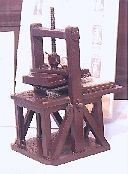- HOME
- VISIT
- ABOUT
- TOURS
- VISITOR FAQs
- LOCAL RESOURCES
- FAST FACTS
- MOAH HISTORY
- WILLIAMS HOUSE
- VICTORY GARDEN
- BOARD AND STAFF
- EXHIBITS
- CURRENT EXHIBIT
- PERMANENT EXHIBITS
- FUTURE EXHIBITS
- PAST EXHIBITS
- ARCHIVED EXHIBITS
- COLLECTION
- COLLECTION HISTORY
- DONATE TO THE COLLECTION
- SEARCH COLLECTION
- PROGRAMS & EVENTS
- CALENDAR
- ADULT PROGRAMS
- CHILDREN'S PROGRAMS
- ANNUAL EVENTS
- PAST EVENTS
- SPECIAL EVENTS
- GET INVOLVED
- MEMBERSHIP
- VOLUNTEER
- GIFT OPPORTUNITIES
- STAY CONNECTED
- EMAIL SIGNUP
- NEWSLETTERS
- PRESS
- Membership Response
The Renaissance period: 1100 AD to 1650 AD
Most people associate the Renaissance with Italy, but the beginnings of the phenomenon can be found in twelfth century Spain, where scholars spent considerable effort in recovering and translating Classical era manuscripts. For purposes of this exhibit, the dates above are considered to cover Renaissance influences.Printing
Until the advent of printing, books and other documents were all inscribed by hand. Good penmanship was a necessary skill for an author, whose works would be duplicated by an array of copyists who spent their days replicating written works. Some handwritten documents are works of art, incorporating color or monochrome images. In the case of Asian or Arabic writings, calligraphic scrolls are often considered art.The Chinese were printing books using wooden blocks carved with pictograms as early as A.D. 868. Brass type was used in Korea around 1100 A.D. The notion of movable type spread from the Chinese to the Arabs in the eighth century, and was subsequently passed on to Europe in the twelfth and thirteenth centuries. Europe adopted the idea around 1450, when the German Johannes Gutenberg (c.1398-c.1468) developed movable type, in which separate pieces of type print each letter on a handpress. He produced a Bible with double columns and 42 lines to a page. His "42-line Bible" established the era of mechanical printing in Europe, although the use of printing was limited until other books began to be printed. Gutenberg's basic process remained in use for 350 years until the invention of power-driven presses, which allowed books to be printed more easily.
Venice rapidly became the center of Europe's printing industry, as the local culture was more tolerant of printed works with "popular" content.
 Gutenberg's press, the associated type, and the availability of cheap paper that
displaced expensive animal skin vellum and parchment made printing much more efficient
and opened the way to the production of books, newspapers and other material at much
lower cost. The rapid drop in the cost of printed material hastened the spread of
literacy and transformed society, creating the basic condition for the Industrial
Revolution: a literate population.
Gutenberg's press, the associated type, and the availability of cheap paper that
displaced expensive animal skin vellum and parchment made printing much more efficient
and opened the way to the production of books, newspapers and other material at much
lower cost. The rapid drop in the cost of printed material hastened the spread of
literacy and transformed society, creating the basic condition for the Industrial
Revolution: a literate population.
Printed information, remains the most widely used form of information storage today, accounting for well over 90% of the world's stored information. Will the stored byte completely displace the printed word? It seems unlikely, since people can not read stored data until it has been converted to characters and images visible to the eye. While machine storage won't displace printing for information distribution, can it displace paper as an archival medium? Maybe not -- you can still read a Gutenberg Bible, but just try to find a device that will retrieve data from an early computer tape drive. And the advent of the computer age seems to have increased the demand for printed pages.
Graphic information storage
The period of the renaissance produced many improvements in the techniques of storing a representational image as a painting or as sculpture. Many of the works of the period were portraits or images of important or well known places. The artists were, in many respects, the equivalent of todays photographers and photojournalists.
The storage of sound
The carillon and music box are examples of the storage of information--in this case, music--in the form of a mechanical read-only memory. The carillon was invented in the 14th century, using wooden pins in a rotating cylinder or disk to program a sequence of bell or chime strikes.
The music box, invented in 1796, makes use of a rotating cylinder in which metal pins are impressed. As the cylinder rotates, the pins pluck the prongs of a metallic harp, producing the notes of the tune to be played. A disk version, using holes in the disk to represent the sounds, appeared in 1870. The carillon and music box are the forerunners of the player piano and the Compact Disc.

|
This page
last updated: May 6, 2010 Original content: Copyright © 2000, 2001, 2002-2010 Museum of American Heritage Trademarks are the property of their owners |
 |
Join today! Membership dues help sustain MOAH. For more information and to download a Membership Form
LEARN MORE HERE
For questions and comments
Contact Us.
Mailing Address
PO Box 1731, Palo Alto, CA 94302
351 Homer Avenue
Palo Alto, California
p. 650.321.1004
e.



